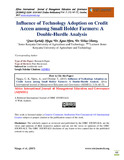| dc.contributor.author | Njogu, Grace W. | |
| dc.contributor.author | Njeru, Agnes | |
| dc.contributor.author | Olweny, Tobias | |
| dc.date.accessioned | 2018-06-13T08:56:10Z | |
| dc.date.available | 2018-06-13T08:56:10Z | |
| dc.date.issued | 2017 | |
| dc.identifier.citation | Njogu, G. K., Njeru, A., and Olweny T., (2017). Influence of Technology Adoption on Credit Access among Small Holder Farmers: A Double-Hurdle Analysis. Africa International Journal of Management Education and Governance (AIJMEG), 2 (3), 60-72. | en_US |
| dc.identifier.issn | 2518-0827 | |
| dc.identifier.uri | http://hdl.handle.net/123456789/3587 | |
| dc.identifier.uri | http://repository.mut.ac.ke:8080/xmlui/bitstream/handle/123456789/3587/Influence%20of%20Technology%20Adoption%20on%20Credit%20Access%20among%20Small%20Holder%20Farmers%201.pdf?sequence=1&isAllowed=y | |
| dc.description.abstract | The proportion of bank lending to the agricultural sector is generally low across the globe, and the situation is no different in Kenya. This is despite the fact that commercial banks have continued to launch tailor-made loan products that target specific groups in the sector. Studies acknowledging low credit volume in the sector have mostly focused on supply side factors that account for the status. This paper investigated mobile banking technology adoption as a factor influencing the level of agricultural credit demand by agricultural households. Using data from dairy farmers, the study explored the relationship between an individual’s espousal of mobile banking technology and the likelihood to access a commercial bank loan through the mobile-banking platform. Specific social-demographic factors were hypothesized to moderate the relationship between mobile-banking technology adoption and credit access. The study was anchored on the fact that the world is swiftly transiting from an industrial to a knowledge-based technological environment for sustainable development. In line with this, commercial banks have been in the forefront in substituting traditional banking models with innovative technology based models in offering banking services including credit An individual’s espousal and frequency of use of mobile banking platform were used to assess a potential borrower’s the level of technology adoption. Using the double- hurdle methodology, an assessment of the likelihood of participating in bank credit market using mobile technology services was analyzed using a normal Probit model. Then, a truncated Tobit model was used to evaluate the loan amount requested for, using data from respondents with positive credit amounts. Survey data was collected using a stratified random sampling from 243 households engaged in dairy farming within the study area. Findings revealed that technology adoption influence both the credit access, and the level of credit demand by dairy farmers from the commercial banks in the study area. Borrower’s age and education level were found to moderate the relationship between technology adoption and credit access. The implication of the findings was that is that to increase loan volume, banks should put in place strategies to market all services on the mobile banking platform, including loan application. Further, the interventions should include targeted financial literacy programs with aspects of technological education among clients in the higher age brackets, as well as clients with low education status who reported low adoption. | en_US |
| dc.language.iso | en | en_US |
| dc.publisher | Africa International Journal of Management Education and Governance | en_US |
| dc.subject | Double-Hurdle, Sustainable, Credit, Access, Technology, Agriculture | en_US |
| dc.title | Influence of Technology Adoption on Credit Access among Small Holder Farmers: A Double-Hurdle Analysis | en_US |
| dc.type | Article | en_US |

